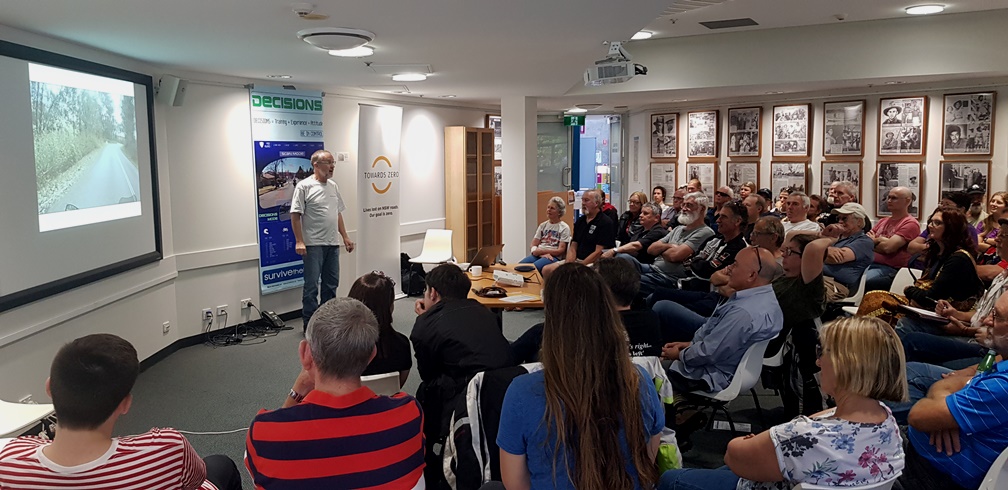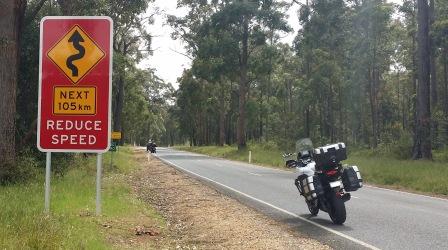The dictionary defines Attitude as a settled mode of thinking. Right attitude for motorcycle riders means thinking about your riding before you ride as well as while you ride.
Thinking about your riding begins before you buy your bike! Think about your level of skill. Does it match the bike of your dreams? Do you need more experience or training? If so, get that experience or training off the road and away from the added dangers of the open road. And make sure you improve both your physical and mental skills.
A good training course is probably a lot cheaper than the replacement parts you’ll need if you drop your bike through lack of experience.
The right attitude is knowing that a course will teach you more about yourself and your bike in a day, than you’ll learn in a year of trial and error.
And if you want to race your motorcycle, go ahead – but not on the street. Join a club and race at a track.
First and foremost
Remember that the public road is designed, built and maintained primarily to allow cars, trucks and buses to transport people and goods from one place to another.
While motorbikes have been around for just as long as cars, trucks and buses they are a very small percentage of the vehicles on Australian roads. The road authorities have very limited funding. This fact of life has two primary outcomes:
1 – Governments must focus on the people that make up the vast majority of road users.
2 – Motorcycle riders have no choice but to work within a road system that is not designed for our enjoyment.
Scan, Anticipate and Respond
Scanning for possible hazards and anticipating what might go wrong are your first lines of defence on the road. It’s not just looking, but quickly searching for possible dangers.
You have to get yourself into the heads of other drivers and pedestrians. You have to concentrate and look for clues about what they might do. And once you anticipate a possible danger, respond quickly to avoid it – don’t wait until it’s too late.
Noticing details, especially those that could be possible hazards, is a good riders best survival technique. Develop a routine or system to scan the road ahead and check the mirrors every 3 – 5 seconds. Vehicles approaching quickly from behind can also be a danger.
Anticipate others silly moves and mistakes. Expect drivers and pedestrians to get in your way because they either don’t see you or think you can go around them. Be ready to respond early to give you plenty of time to avoid a possible danger. If in doubt, “Set-up” the brakes and be ready to stop.
Speed = Space and Time
It might sound obvious, but ride at a speed that is appropriate for the area and the conditions. And stay within the speed limits. The faster you go, the longer it takes to stop and the less time you have to respond to a hazard.
Be Patient
If you expect drivers and pedestrians will make mistakes, you won’t be annoyed when they do. Good riders are patient riders. They treat other road users with respect – just like they want to be treated.
Act With a Clear Head
When you’re affected by alcohol or drugs your reactions are much slower than when you are sober. Your balance, scanning skills and reflexes are seriously affected so you can’t react quickly to a dangerous situation.
Losing your temper in traffic or riding when angry will only cause you to be distracted and make risky choices. Keep your cool and avoid a crash.
Maintain a Buffer Zone
Having the right attitude means maintaining the right buffer zone between you and other vehicles. In the dry, you need a 3 second gap from the vehicle in front so you have time to stop or avoid potholes, etc. You need 6 seconds in the wet because your tyres don’t have as much grip.
The 3 or 6 second gap is easy to work out. Pick a point on the side of the road and as soon as the vehicle in front passes it start counting – one thousand and one – 1,002 – 1,003. If your front wheel goes past the point before you’ve finished counting you are too close so drop back a bit.
You also need to stay away from oncoming vehicles, parked cars, pedestrians and vehicles in the lane beside you. The best position in your lane is always a compromise. Try to keep the most space between you and the biggest danger, without riding over potholes, spots of oil, rocks, etc.
Good riders often move around in their lane as dangers change with each stretch of road. They scan a long way ahead so they have time to pick the biggest danger.
Head Checks
Noticing details is all part of a rider’s general scanning routine. This includes checking your blind spots. Some bikes have bigger blind spots than others.
When changing lanes, first use the indicators and second, look over your shoulder and check the blind spot. If its clear you are safe to change lanes.
Some dangers move very quickly. Before moving off from the lights, check left and right for “red-light-runners”
Knowing Your Limit
As riders we think we are highly skilled and capable of managing any emergency (… just waiting for the call to replace Rossi in the next MotoGP…). In reality we all have to abide by the limits that represent the harsh reality. These limits include:
- The road conditions – dry, wet, sand, gravel, sticks, debris, oil, white lines, etc
- Our personal riding ability – fitness, mental skills, fatigue, overall riding experience.
- Our bikes’ limits – ground clearance, tyre condition and pressure, suspension, condition of the brakes, power, etc.
The more experience we have as riders in different conditions and on different roads the more we learn about what we and our bikes can manage.
When we change bikes, many of the lessons start all over again. Increased engine and braking capacity and changed riding position means we have to relearn some basic lessons.
Many older riders returning to bikes after 15 years or so have similar problems to new riders who have just completed their P’s. Dusting off the old licence for a modern bike and the upgrade from a low powered Learner and Provisional approved bike takes the rider to a brand new experience. The incredible power to weight capability, amazing brakes and grippy tyres of modern bikes often contribute to a serious crash early in the learning curve. Even cruiser bikes now have brakes and tyres that are more than capable of creating huge problems for riders with limited experience or rusty skills.
There is no substitute for experience, however, we need to be learning new lessons and not just repeating the lessons of the past few months regardless of how long we have been riding.
Learning about your limits starts with open discussions with other riders about the mistakes made on the last ride. It’s also a good idea to contact an accredited riding instructor who can not only analyse your problems but also help you develop a practical solution. Advanced riding courses and personal lessons might seem expensive but compared to the cost of replacement mirrors, foot pegs and muffler they are actually fantastic value (not to mention the time off the road, hassles with insurance companies, medical bills, explaining the crash to your partner, etc).
And the more experience and training you get the more you will enjoy the ride.





